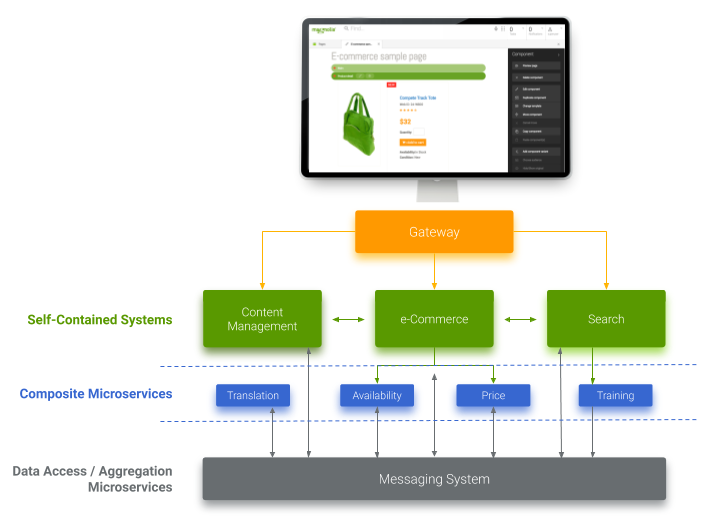- Jun 17, 2020
- 6 min
The Commerce Paradigm Shift Towards CMS
The State of CMS in the Retail Sector
Magnolia in action
Take 12 minutes and a coffee break to discover how Magnolia can elevate your digital experience.
It’s not often we can use the term ‘Paradigm Shift’ but I think that is currently true for commerce right now.
There is a ‘fundamental change in approach’ which is being borne from years of high expenditure, overly complex implementation efforts and ever more ‘agile technology’ that is bringing retailers back to the drawing board.
Probably the best way to describe the situation is ‘cumbersome’. That definition is just as interesting as ‘paradigm shift’ in its meaning; ‘slow or complicated and therefore inefficient’.
Why is everyone in a cumbersome state and what is the paradigm shift going on?
Ecommerce platforms have typically been the go to route in ensuring you can have a digital presence, market the brand, merchandise the range and manage cart, payment and fulfillment. Over time, the general output of these implementations demonstrated the definition of cumbersome and so a newer wave of re-platform projects ensued.
Unfortunately, what were the benefits then (being hosted, revenue share models, add-on platform modules), have not yielded the pace, agility and collaboration required to compete on the digital stage. To add to the complexity, focus then shifted to mobile first, omni-channel experience, personalisation, loyalty and analytics - which still today make up an element of the competitive battleground of Customer Experience (CX).
The business built departments to accommodate the differing needs of the go to market strategy and so in essence siloed the lines of business and lengthened the processes. More plugin’s, more interfaces, more expertise, more cost and so increased manual effort and/or duplication of effort; it has ended up with a need to simplify the operating model - again.
Retail is now in a headless race to get to a Monday trading meeting with positive performance or a clear understanding of how to achieve the desired goals. Week-on-week, month-on-month and year-on-year - always the same model, not daring to shy away from last year's campaign strategy for fear of missing the targets. Yet, the cumbersome nature means that IT are needed more frequently than ever; they have a huge backlog of change requests and release cycles are very infrequent (because of the intensity of the process and the risks at stake). More workarounds are created, the operating model just became more complex, inefficient and therefore back to cumbersome.
A new headless has come on the scene and if we peel back the layers as to why, it helps set the theme.
‘Headless commerce’ is now leading the way in retail digital tech bingo but yet why is it really taking hold. “Headless commerce; but yet I need a head”. Whilst by name it seems to define taking the head off a commerce engine, there is a bigger story behind it, which has actually been running in other verticals for a while - The Content Management System. These technologies are what all other online websites utilise to run their digital presence, they have just not had a voice in retail per se, because the ecommerce platform created a demand around an all-in-one model, which, by design, was the problem we now know of.
Before we get into Content Management Systems (CMS) - what is the link to headless?
Probably the two key elements of headless are UX agility and Content reuse. Tesco for example have gone from 40+ day release cycles (which is fast as we currently know it) to now sometimes hours, borne on these two principles. Allow the presentation layer to be decoupled from the content, the content to be decoupled from the commerce and so each work in parallel; limiting the dependency on each other. Content, however, has always been the missing focus and probably where ‘headless’ gets its best use case.

Content Management should be about an effective content strategy. Model the content in a specific way that multiple items can be reused across pages, experiences, sites, devices and channels so that curating experiences becomes an easier focus on combinations and changes can be made once and published everywhere.
This notion of COPE (create once, publish everywhere) is the base driver of headless and where many inefficiencies lie. Having to update many pages is the norm and content is too structured in commerce platforms so once this concept is understood, information architecture becomes the holy grail of headless.
Now a baseline of understanding is in place, the additional layers keep adding efficiencies and more importantly speed, as content now is made up of multiple items to form an experience. Assets that reside across the architecture (e.g. images, banners, video’s, reviews, content articles, blogs, social/ugc, reviews) can all be seen inside one creative area and it can be repurposed across channels, devices, locales, be translated and targeted - but all from a flexible and reusable base - the ‘content pool’.
Retail as a vertical never really understood what an effective content management system could do for them and so now this more open architecture, the fragmentation of content items and standard working practices (e.g. workflow, versioning, audits) help the IT team focus on innovations and the marketing team to manage their experiences.
Headless CMS however has a major flaw. The marketers that leverage content of all types to create experiences have lost their visual aid - the Page Editor. So with it has gone:
Creative Control (the ability for complete experience assembly)
Context (prepare for the meaning of the experience)
Live Preview (to visualise and test the experience ahead of publishing or approval (by device, channel, targeted audience, language/region, time/date)
For ecommerce departments who win or lose in the consumer battleground by the Customer Experience (CX) alone; the current methodology is a problem - a BIG problem. As others move toward this new design and agility, many still have an IT led commerce practise with marketing being the tail.
This Straight Talking Research guide highlights the clear disconnect between the IT and marketing departments; they have never seen eye to eye, each bemoaning the other for their understanding of the bigger picture.
The solution lies in this point alone - bridge this disconnect and you create not only harmony, but parallel working patterns and most importantly speed. Which if you ask any person in commerce today is desperately sought after.
Magnolia CMS has found a way to simplify the operating model and unify the teams based on one thing, which funnily enough has been the end goal for everyone - the experience.
If we can make a best in class authoring experience, built on a fast developer experience we can of course create the valued customer experience.
How so?
Make sure the business has preview capability - delivering a competitive experience starts on the assembly line (see Headless with no limits)
By keeping the architecture de-coupled and therefore best of breed and future-proofed - but making light of the integration points so marketers have a centralised hub to build an experience from all that is required (see Light Integrations)
Provide all the marketing capabilities of an enterprise-grade CMS so IT remains focused outside of delivering page templates/functionality/add-ons.
The tipping point to change is the realisation that you are slow or complex and therefore inefficient (e.g. cumbersome). The current practices are not really the norm anymore and so businesses need to understand the stepping stones to success. This doesn’t have to be a huge digital transformational project - there are simple phases or steps that take you towards being fast, competitively fast.
In Summary, cumbersome can be reduced down to CMS to create flexibility, agility, speed and most importantly huge reductions in costs over time. There is no need anymore for huge monolithic platforms that cost a lot to buy and implement, and need continuous money thrown at them; think microservices, go modular and improve the operating model.
Learn more about integrating your CMS and your ecommerce platform.
The State of CMS in the Retail Sector Report
Download the quick-start retail marketer’s guide to content management systems
Magnolia for Retail & Commerce
Magnolia Headless CMS contributes to $230 billion in revenue by integrating content and commerce. Learn what it can do for you.










